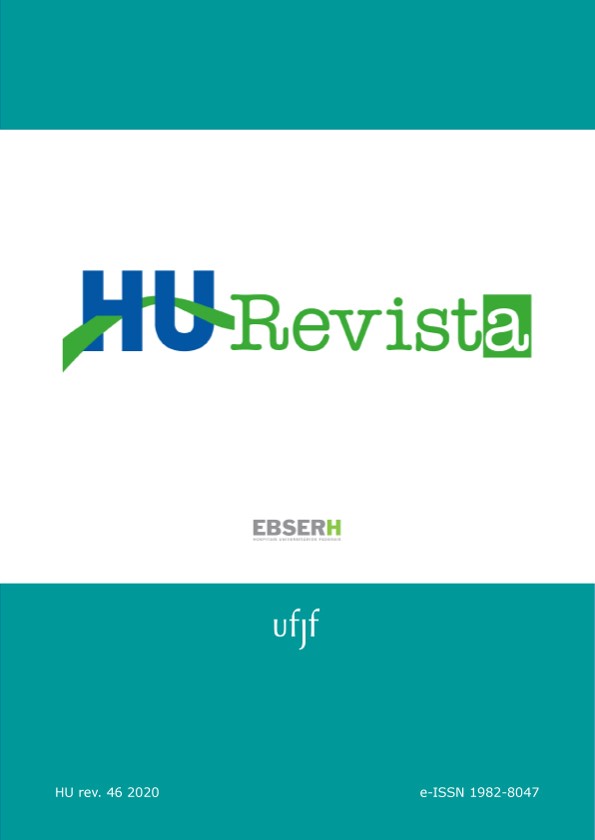Exercise protocol and occlusal splint as an alternative for muscle temporomandibular disorder: case report
DOI:
https://doi.org/10.34019/1982-8047.2020.v46.30307Keywords:
Temporomandibular Joint Disorders, Bruxism, Facial PainAbstract
Introduction: Temporomandibular muscle dysfunction requires a multidisciplinary approach to consolidate comprehensive treatment. Objective: To report a case where the effects of an 8-week protocol of muscle resistance exercises to fatigue controlled by biofeedback associated with the use of an interocclusal device in the treatment of muscle temporomandibular disorder were evaluated. Case Report: The Diagnostic Criteria for Research on Temporomandibular Disorder (RDC/TMD), Visual Analog Scale (VAS) and Electromyographic Assessment (EMG) were used for screening and diagnosis. Female patient, 25 years old, leucoderma, attended the Dental Prosthesis Clinic complaining of jaw pain upon waking. He reported the nocturnal habit of grinding his teeth and symptoms such as: sporadic noises in the ear and pain in the cervical region. After diagnosis of temporomandibular muscle dysfunction, by RDC/TMD, a physiotherapeutic treatment based on weekly progression exercises performed twice a week was used, totaling 16 sessions, including assessments of fatigue time and perceived pain in the first 24 hours and after 4 and 8 weeks after the beginning of the protocol. In association, an interocclusal device was used at night with intervals of 7, 15, 30, 60 and 90 days in dental follow-up consultations for reexamination and occlusal adjustments of the device. At the end of the instituted therapy, the patient was again submitted to RDC/TMD, EVA and EMG. Results: A significant reduction in painful symptoms was found when comparing the values obtained in the pre and post-treatment evaluations, corresponding to a rate of approximately 89%. Conclusion: The association of dental and physical therapy therapies has shown effectiveness in reducing symptomatic pain, promoting comfort to the patient and greater range of motion of the temporomandibular joint.
Downloads
References
Lugo LH, García HI, Rogers HL, Plata JA. Treatment of myofascial pain syndrome with lidocaine injection and physical therapy, alone or in combination: a single blind, randomized, controlled clinical trial. BMC Musculoskelet Disord. 2016; 17:101. doi: 10.1186/s12891-016-0949-3.
Canales GT, Lora VRMM, Gonçalves LM, Grillo, CM, Barbosa CMR. Eficácia terapêutica da associação do aconselhamento e do aparelho estabilizador plano sobre a dor crônica presente na dor miofascial. In: 32ª Reunião Anual da Sociedade Brasileira de Pesquisa Odontológica: 2015; Campinas. Anais. Brazilian Oral Research. 2015; 29(Suppl. 1):72.
Chaves TC, Oliveira AS, Grossi DB. Principais instrumentos para avaliação da disfunção temporomandibular, parte II: critérios diagnósticos; uma contribuição para a prática clínica e de pesquisa. Fisioter Pesqui. 2008; 15(1):101-6.
Reis LO, Furtado JF, Miranda JS, Dias IM, Leite FPF. Prevalência de dor miofascial em pacientes com desordem temporomandibular. HU Rev. 2016; 42(3):225-9.
Torres F, Campos LG, Fillipini HF, Weigert KL, Vecchia GF. Efeitos dos tratamentos fisioterapêutico e odontológico em pacientes com disfunção temporomandibular. Fisioter Mov. 2012; 25(1):117-25.
Dutra LC, Seabra EJG, Dutra GRSF, Silva AP, Martins YVM, Barbosa GAS. Métodos de tratamento da disfunção temporomandibular: revisão sistemática. Rev Aten Saúde. 2016; 14(50):85-95.
Barbosa MA, Tahara AK, Ferreira IC, Intelangelo L, Barbosa AC. Effects of 8 weeks of masticatory muscles focused endurance exercises on women with oro‐facial pain and temporomandibular disorders: A placebo randomised controlled trial. J Of Oral Rehabil. 2019; 46(10):885-94. doi: 10.1111/joor.12823.
Alqutaibi AY, Aboalrejal NA. Types of Occlusal Splint in Management of Temporomandibular Disorders (TMD). J Arthritis. 2015; 4(4):1-4. doi: 10.4172/2167-7921.1000176
Candirli C, Korkmaz YT, Celikoglu M, Altintas SH, Coskun U, Memis S. Dentists’ knowledge of occlusal splint therapy for bruxism and temporomandibular joint disorders. Niger J Clin Pract. 2016; 19(4):496-501. doi: 10.4103/1119-3077.183310
Ella B, Ghorayeb I, Burbaud P, Guehl D. Bruxism in movement disorders: a comprehensive review. J Prosthodont. 2017; 26(7):599-605. doi: 10.1111/jopr.12479
Amorim CSM, Espirito Santo AS, Sommer M, Marques AP. Effect of physical therapy in bruxism treatment: a systematic review. J Manipulative Physiol Ther. 2018; 41(5):389-404. doi: 10.1016/j.jmpt.2017.10.014.
Torres F, Campos LG, Fillipini HF, Weigert KL, Vecchia GF. Efeitos dos tratamentos fisioterapêutico e odontológico em pacientes com disfunção temporomandibular. Fisioter Mov. 2012; 25(1):117-25.
Ries LGK, Graciosa MD, Soares LP, Sperandio FF, Santos GM, Degan VV et al. Efeito do tempo de contração e repouso na atividade dos músculos masseter e temporal anterior em indivíduos com DTM. CoDAS. 2016; 28(2):155-62. doi: 10.1590/2317-1782/201620150112
Cho GH, Lee Y. Analysis of masticatory muscle activity based on presence of temporomandibular joint disorders. Med Sci Monit. 2020; 26:e921337. doi: 10.12659/MSM.921337
Dickerson SM, Weaver JM, Boyson AN, Thacker JA, Junak AA, Ritzline PD et al. The effectiveness of exercise therapy for temporomandibular dysfunction: a systematic review and meta-analysis. Clin Rehabil. 2017; 31(8):1039-48. doi: 10.1177/0269215516672275.
Celinski AI, Cunali RS, Bonotto D, Farias AC, Cunali PA. Eletromiografia de superfície em disfunção temporomandibular: revisão sistemática. Rev Dor. 2013; 14(2):147-50.
Mapelli A, Zanandrea Machado BC, Giglio LD, Sforza C, De Felício CM. Reorganization of mus¬cle activity in patients with chronic temporomandibular disorders. Arch Oral Biol, 2016; 72:164-71. doi: 10.1016/j.archoralbio.2016.08.022.
Guaita M, Högl B. Current treatments of bruxism. Curr Treat Options Neurol. 2016; 18(2):10. doi: 10.1007/s11940-016-0396-3.
Armijo-Olivo S, Pitance L, Singh V, Neto F, Thie N, Michelotti A. Effectiveness of manual therapy and therapeutic exercise for temporomandibular disorders: systematic review and meta-analysis. Phys Ther. 2016; 96(1):9-25. doi: 10.2522/ptj.20140548.
Sassi FC, Silva AP, Santos RKS, Andrade CRF. Tratamento para disfunções temporomandibulares: uma revisão sistemática. Audiol Commun Res. 2018; 23:1-13.
Moraes AR, Sanches ML, Ribeiro EC, Guimarães AS. Therapeutic exercises for the control of temporomandibular disorders. Dental Press J Orthod. 2013;18(5):134-9. doi: 10.1590/s2176-94512013000500022.
Downloads
Published
How to Cite
Issue
Section
License
Cessão de Primeira Publicação à HU Revista
Os autores mantém todos os direitos autorais sobre a publicação, sem restrições, e concedem à HU Revista o direito de primeira publicação, com o trabalho licenciado sob a Licença Creative Commons Attribution que permite o compartilhamento irrestrito do trabalho, com reconhecimento da autoria e crédito pela citação de publicação inicial nesta revista, referenciando inclusive seu DOI.









